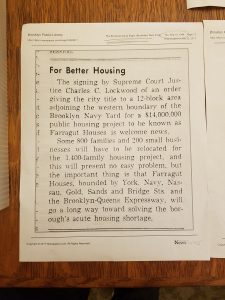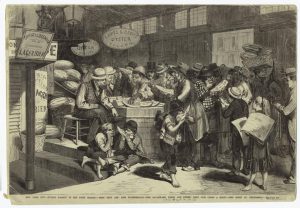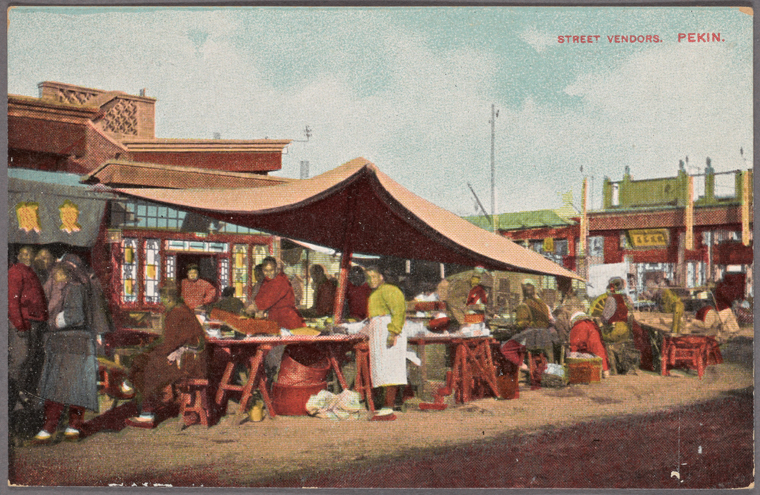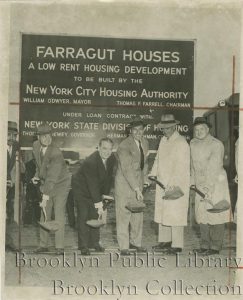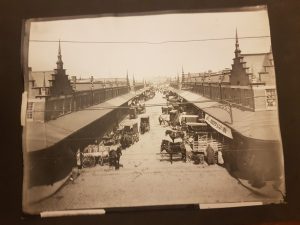I found this article talking about making better housing for low income families on Sept 19, 1946. The city was proposing public housing (Farragut Houses) to solve the housing shortage. They proposed housing for 1,400 families which was great but it still had a negative side to it. The negativity was that 800 families and 200 small business had to relocate because of it. Even though the city was trying to solve the problem of housing shortage but they gave a bigger problem to the people that were already there. I am wondering if that’s the reason why Vinegar Hill downgraded. Maybe the Farragut Houses are the reasons people left. Or even the reason why Vinegar Hill isn’t developing. I understand that it helped low income families but at the same time it hurt that people that were residing and working there. I wonder if other neighborhood went through the same problems.
Monthly Archives: April 2017
Armend Sela BLOG #2
https://digitalcollections.nypl.org/items/510d47e0-d816-a3d9-e040-e00a18064a99
I chose this picture for this blog because it clearly depicts a mass of people walking in a market district. This picture will help us fortify our hypothesis, which is that the opening of Wegmans Market will increase the amount of people entering the Navy yard form Vinegar Hill, thus strengthening the relationship. You can see people eating a type of fruit in the picture, and many people passing by. These markets are crucial for a positive development in a community. It creates a boom in the economical market, creating jobs and selling more items. As of today, residents in Vinegar Hill must walk 2 miles to be able to buy fresh produce, So an opening of this market will be convenient for the residents in Vinegar Hill and for people that live around the market.
RADIO BROADCASTS
Here are two radio broadcasts about Farragut Houses residents, the waterfront, the changing neighborhood and the involvement of the community in the local school. They are 6 minutes and 3 minutes long. Perhaps they can help some of the teams with your projects.
Longtime Residents Witness Brooklyn Waterfront’s Changing Fortune
http://www.wnyc.org/story/community-s-watched-change-unfold-along-brooklyn-waterfront/
History Repeats Itself in Brooklyn School Rezoning
http://www.wnyc.org/story/history-repeats-itself-two-brooklyn-schools-changing-neighborhoods
Jarryd Blog #2
https://digitalcollections.nypl.org/items/c262501b-0379-8402-e040-e00a18060146
I chose this picture for my blog post because it symbolizes the hypothesis my group is researching. We plan to prove the strengthening of relationship between the Brooklyn Navy Yard and Vinegar Hill through the opening of Wegmans supermarket. This picture is more of a street vending representation rather than an actual indoor supermarket like Wegmans but the atmosphere is what i would like to believe to be the same. There is a physical lack of an affordable produce supermarket in Vinegar Hill and adjacent areas near it. Residents have to travel great lengths to acquire such foods. The newly developed supermarket as well as other developing buildings should bring about a positive change.
Annotated bibliography assignment due April 19, after Spring Break
Today each group presented their hypothesis and received generous feedback from the class — thanks for contributing, everyone. The annotated bibliography group assignment is due by the start of class on Wednesday, April 19. Get in touch with questions early – do NOT wait until the night before it is due! As your group’s research continues, you may find the New York City Research Guide useful. You may also want to search the Brooklyn Eagle and the New York Public Library’s Digital Collections to find additional primary sources to include in the annotated bibliography. Over the break you may have time to continue your research in the Brooklyn Collection, the New York Public Library, or the New-York Historical Society — in person, rather than solely online.
Don’t forget – on Thursday, April 20, classes run on a MONDAY SCHEDULE. This means we meet Wednesday, April 19 and Thursday, April 20.
Enjoy break, everyone!
Site Report 04 | McManus
Mid-Term Grades
Mid-Term Grades are posted on Blackboard.
The Research Question and the Paper Outline
Yesterday we worked on your research questions to make them as productive for your projects as possible. We also discussed the importance of the outline as the structure that will hold your paper as well as the need to sort out the data you collected so far.
The outline starts from the research question. For Wednesday start to identify subtopics that you need to answer your research question and start to organize these subtopics. Bring your preliminary outline work to class.
Outlines can take many forms but for preliminary understanding check out these links: https://owl.english.purdue.edu/owl/resource/544/02/
http://www.albany.edu/eas/170/outline.htm
On Wednesday we will talk about annotated bibliography as a tool to help you sort out and evaluate your data and make it useful for your project. We will also continue to discuss the paper outline.
Breaking Ground for More Homes
By Lana Belopukhova, April 3, 2017 / Comments 150
Breaking ground for more homes, Brooklyn, NY, US. Sep. 8, 1949. “Eagle Staff photo.”
This photo represents all Dignitaries with shovels at the foundation laying ceremony for the construction of a residential house near the Brooklyn Naval Court. “Breaking Ground for More Homes”: at ceremonies in a downpour at the corner of Gold and Prospect St., officials dig silver shovels into the soil to mark the beginning of construction of Farragut Houses, new low-rent housing project. We can see from left to right are: Borough President Cashmore, Mayor O’Dwyer, State Housing Commissioner Herman T. Stichman, City Construction Co-Ordinator Robert Moses and Thomas F. Farrell, chairman of the City Housing Authority.
Blog # 2 – Mark Yakub
This image is a vendor market where the vendor either sell their products or where they distribute their product. The reason I chose this image is because my groups hypothesis is about the development of a Wegmans Supermarket in the Brooklyn Navy Yard. The neighborhood of Vinegar Hill and the area surrounding the Navy Yard has no supermarket so the residents have to travel long distances to get groceries. The development of this supermarket will open a gate to a new relationship between the Vinegar Hill and the Navy Yard. This will strengthen the relationship between the two isolated areas.

